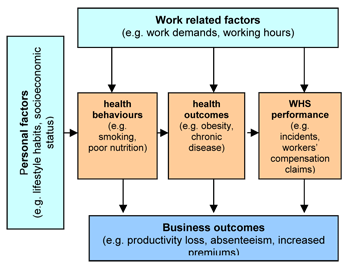Integrating health, safety and wellbeing
Addressing work health, safety and wellbeing together will support workers' health and reduce work-related injuries and illness.
Integrated approach
Integrated approaches to work health combine occupational safety and injury prevention with health and wellbeing to enhance worker health and prevent work-related injuries and illness.
The Principles of Good Work Design highlights that focusing on good work design and integrating and improving work health and wellbeing into that design can lead to improved business success through higher worker productivity.
Good work health and safety systems can easily incorporate work health and wellbeing risk management into existing policies and procedures, because the fundamental goals and principles are like safety.
| Goals | Principles |
|---|---|
|
|
Work and health interactions
Good work prevents ill health and good health allows workers to be more productive.
Good work design for health
Good work design prevents poor health from work related musculoskeletal disorders, mental health disorders, dust, asbestos, chemical related disease (such as asthma and contact dermatitis), infectious and zoonotic disease, noise induced hearing loss, skin cancer and other occupational cancers.
Well designed and managed workplaces can help support worker health and wellbeing through prevention and early identification of chronic disease risks which facilitates faster recovery and return to work after injury or illness. Improvements to the work organisation, work environment, workplace culture and injury management programs are key factors to workers feeling valued and supported in their work roles, but also improving their individual health, wellbeing and productivity.
Good health for work
There is clear evidence the general physical and psychological health of a workforce has a direct impact on work health, safety and wellbeing outcomes. Workers regularly exposed to hazardous working conditions, physically demanding tasks, high levels of stress and long working hours are more likely to smoke, consume too much alcohol, have low levels of physical activity and poor nutrition. Workers who suffer from physical or mental health problems are likely to have higher rates of injury/illness, absenteeism and presenteeism.
Who has responsibilities for work health
Everyone is responsible for ensuring health and safety in the workforce. Under the Work Health and Safety Act 2011 health is defined as both physical and psychological health and outlines the responsibilities of persons conducting a business or undertaking (PCBUs). Duties are also placed on officers of a PCBU, workers and other persons at a workplace.
- PCBUs have a duty of care under section 19 to ensure, so far as is reasonably practicable, the health and safety of their workers while they are at work.
- PCBUs must provide and maintain a work environment without risks to the health of workers, or other persons affected by the conduct of the business or undertaking.
- Workers also have a responsibility under section 28 to take reasonable care for their own health and safety, and to comply with reasonable safety instructions.
Managing work health
Whilst the Work Health and Safety Act 2011 provides no legislative requirement in Australia to integrate health, safety and wellbeing, it can be interpreted that the workplace has an obligation to ensure the work and the work environment does not lead to injury or illness. Managing chronic disease risks can influence and improve worker health and safety performances and business outcomes.
The model below outlines how workplace factors influence worker health, health behaviours and safety performance of the business.

Injury management, rehabilitation and return to work outcomes
Employers adopting early interventions that address chronic disease risks can help to reduce physical and psychological injury and improve return to work outcomes.
Supporting injured workers in getting back to work makes good business sense. The potential savings from supporting early return to work can help businesses maintain operational requirements and minimise claim costs that impact on workers' compensation premiums. The costs associated with hiring additional labour and training new workers can be minimised by helping workers get back to work.
Getting workers back to work supports the approach outlined in Realising the Health Benefits of Work. Find out why work plays an important role in any rehabilitation process by watching this film by the The Royal Australasian College of Physicians Position Statement on realising the health benefits of work.
When an injury does occur there are many different actions you can take. Health and wellbeing are one way to encourage better return to work outcomes. You can find more information about rehabilitation and return to work on our website.
Assessing for an integrated approach
It is important to identify the opportunities within your organisation where you can integrate health and wellbeing into existing systems.